- Sail Loot Podcast 063: Sailing With FIRE on Luna Sea with Mark and Jennifer
- Sail Loot Podcast 062: Andersons Abroad own Sea-Tech Systems to make Sailing Money
- Sail Loot Podcast 048: Neil Davies Sails to Cuba and Works Remotely for Sailing Money
- Sail Loot Podcast 042: Wiley Sharp, Part 2 – Owning and Operating a Virgin Islands Sailing Charter
- Sail Loot Podcast 037: Salty Times Sailing to find the Surf with Base and Jamie
- Sail Loot Podcast 027: Couchsailors Jose and Gina Rent All of their Rooms for Sailing Money
- Sail Loot Podcast 020: Leah Kruger Makes Her Sailing Money With Brio
- Sail Loot Podcast 019: Good Anchorage, Get Paid To Cruise
- Sail Loot Podcast 013: Investing Money to Make Money While Sailing the Mediterranean with Franz Amussen
- Sail Loot Podcast 012: From Corporate America to Ottsworld with Sherry Ott
Bareboat Cruising Course: The Third Step To Improving Our Sailing Skills – Day 2 (Day 5 Aboard Allison)
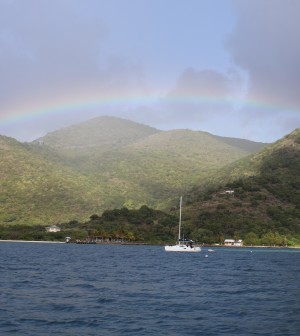
Our 5th day aboard Allison started a little earlier. We had a lot of sailing to do to make up for the time we missed dealing with the steering failure the day before.
We were up enjoying our coffee and the rainbow over Jost Van Dyke before setting sail at 0830.
We had a few things to practice today, but it was our last full day of sailing and at this point the students should’ve known how to do things. We were getting pretty good at performing our cruising tasks, and Rory would give input every once in a while, but I noticed that he was correcting us much less than before. Maybe we were learning a thing or two? I think Rory was also a pretty good teacher.
Fred and I went through the C.O.B.B checks together – Coolant Oil Belts Bilge. We weighed anchor and motored out of Long Bay. Fred and I were splitting captain’s duties today. He started the day at the helm. We were head to wind with plenty of room to raise the sails rather quickly, and so raise the sails is what we did.
Our plan for the day was to sail through Thatch Cut, up through Little Thatch Island and Frenchman’s Cay, and beat over to The Indians for a late lunch. We set our heading for Thatch Cut. We were on a nice broad reach, and wouldn’t you know it…Rory throws the TYPE IV ring buoy floatation device into the water and starts yelling, “MAN OVERBOARD!”
More Man Overboard Drills
It was time to put our training into action. Cindy was assigned to be the spotter, Fred steered Allison onto a beam reach, and Megan and I trimmed the main and jib sheets throughout the first Man Overboard Drill (MOB).
We all knew what to do, but Rory still had to give all of us some pointers as we went through the first MOB drills. After all, this was the first time we were putting all of the MOB maneuvers together on a 44 ft yacht.
When all was said and done I think we performed at least 15 MOB drills. Each student had a chance to be at every crew position 3 to 4 times.
If I must say so, we did pretty well with the MOB drills. The TYPE IV floatation device was saved almost every time. The one time it was not saved was when I was at the helm. However, we performed the MOB drill so well that Rory forgot to get the boat hook extended in time to pick up the floatation device as it slowly bobbed from bow to stern. No worries. I saved what little steerage I had left and got Allison onto a beam reach so that we could try again. I didn’t get the floatation device as close to the hull the next time, but at least the boat hook was ready to go and we were close enough to get it back on board.
Surprisingly, our issues with the MOB drills had to do with the SCUBA tanks that we had on board. In hind site, I think we should have placed the rack for the SCUBA tanks a little further aft. The SCUBA tanks didn’t hold air in them very well when the jib sheets got wrapped around the valve handle and twisted them open. This happened twice when we headed up to a stop at the end of the MOB drill. We had to release the jib sheets in order to allow the jib to luff and help Allison coast to a stop. Unfortunately, our chances of getting a good dive in were decreasing.
Eventually, we convinced Rory that we were good enough at MOB drills to get back onto a broad reach and head towards Thatch Cut.
On a Reach to Thatch Cut
We had been taught how to navigate using paper charts, but Rory also wanted to show us how to use a chart plotter (after all, it was covered in the Bareboat Cruising book). He said, “Fred, and Ted use the chart plotter to get a heading to Thatch Cut.” Rory had quickly gone over the chart plotter once before so Fred and I started leaning over it and pushing buttons to set way points. It took a few seconds to get used to reading the chart plotter in the glare of the sun and to figure out the correct buttons to push, but we eventually figured it out and reported a heading. Then Rory asked, “Is that a True or Magnetic heading.” We replied, “Uhhhhhhh” then looked at the chart plotter. Of course, the heading was a True heading and we had to do some quick math to correct for variation and deviation to get a Compass heading.
We reported the Compass heading and Rory said, “Okay Fred, get us there.” Fred used the compass to get us on course and the rest of us adjusted the sails accordingly. We enjoyed a nice, comfortable 30-45 minute sail to Thatch Cut on a broad reach.
Beating to The Indians
When we arrived at Thatch Cut it was all hands on deck and Rory took the helm. We had to head up and perform some quick tacks in order to get past Soper’s Hole and through the gap between Little Thatch and Frenchman’s Cay.
Rory got us pretty darn close to Little Thatch before we tacked the first time. I think he wanted to show us how quickly and easily it could be done when everybody was ready, knew what they were doing, and on the same page. (It wasn’t until after we had gotten home and done some Wednesday night racing at the lake that I realized we were nowhere near Little Thatch and we had plenty of time to tack Allison).
After the first tack, Rory handed the wheel over to Fred for a few tacks, and then it was my turn. I completed the cut through Little Thatch and Frenchman’s Cay, and continued beating into the wind across Sir Francis Drake Channel.
We had one interesting run-in with a power cat on the rest of our sail to The Indians. No, we didn’t actually run into them, but it was close. We were both off the Northeast end of St. John headed toward The Indians/Norman Island. He was a power cat motoring straight there, and we were the sailing vessel beating our way there.
Who has Right-of-Way?
Eventually, there was a risk of collision between Allison (us) and the power cat. In that case, S.L.O.W doesn’t come into play because they were motoring (their only way to travel on a power cat) and we were under sail. Therefore, we were the stand-on vessel and they were the give-way vessel. We were on a port tack, they were to leeward, they were approaching our starboard side, and they were between us and land (St. John was fairly close actually. We would’ve tacked pretty soon after they gave way.) But none of that matters because they were motoring and we were sailing. Rory said, “Ted, hold your course and speed. We are the stand-on vessel. They are the give-way vessel. But be prepared to tack just in case they don’t know what they’re doing.” So, I called out, “Ready to tack,” and held my course and speed while everybody else made sure the jib sheets were ready.
They either forgot that they didn’t have sails or they didn’t know what they were doing. They didn’t budge. They looked at us like we were the crazy ones, and they may have even used their horn. Rory looked at them, got their attention and pointed to our sails as if to say, “What are you thinking?”
We tacked, and continued on our way to The Indians for lunch and a snorkel. In order to pick up the last mooring ball available at The Indians we had to furl the jib, turn the engines on, head up into the wind, and lower the main sail. We quickly found out that the reason why it was the last mooring ball available was because the eye at the end of the pennant that you are supposed to loop your bow lines through was broken.
Rory to the rescue! Rory quickly ran up to the bow of the boat and held onto the pennant while tying a rolling hitch around it with the port bow line and a round turn and two half hitches around it with the starboard bow line. The rolling hitch stopped the bow line from slipping off of the pennant while the rolling turn and two half hitches was placed between the rolling hitch and the mooring ball to keep us centered. We were there for about 2 minutes before another mooring ball opened up and we moved. I think I’m going to have to master the rolling hitch.
After lunch and our snorkel at The Indians it was just a quick motor over to The Bight on Norman Island where we would spend our last evening aboard Allison.
The Bight is the location of the famous William Thornton (The Willy-T) floating bar and restaurant. As soon as we picked up our mooring ball it was time for a painkiller, but we had one more thing to do first. We had to TAKE OUR FINAL TEST!
So I grabbed a beer instead and sat down at the saloon table, and filled in the answer sheet to my Bareboat Cruising test with my #2 pencil. I passed the test, and so did everybody else! We were all Captains and it was time to celebrate!
We all climbed into the trusty dinghy and headed to The Willy T where we ate, drank, were merry, and of course…We Jumped!


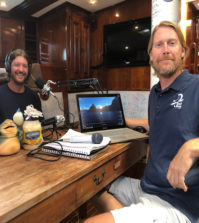
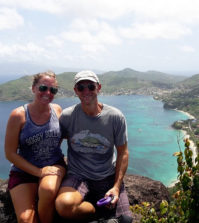
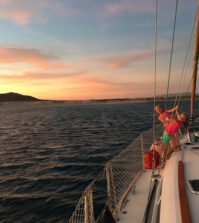

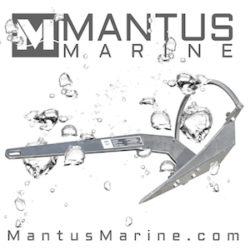

0 comments